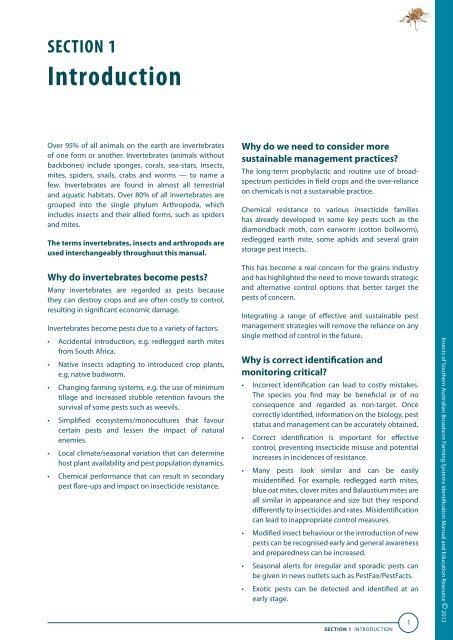Insects of Southern Australian Broadacre Farming Systems - Grains ...
Insects of Southern Australian Broadacre Farming Systems - Grains ...
Insects of Southern Australian Broadacre Farming Systems - Grains ...
You also want an ePaper? Increase the reach of your titles
YUMPU automatically turns print PDFs into web optimized ePapers that Google loves.
SECTION 1<br />
Introduction<br />
Over 95% <strong>of</strong> all animals on the earth are invertebrates<br />
<strong>of</strong> one form or another. Invertebrates (animals without<br />
backbones) include sponges, corals, sea-stars, insects,<br />
mites, spiders, snails, crabs and worms — to name a<br />
few. Invertebrates are found in almost all terrestrial<br />
and aquatic habitats. Over 80% <strong>of</strong> all invertebrates are<br />
grouped into the single phylum Arthropoda, which<br />
includes insects and their allied forms, such as spiders<br />
and mites.<br />
The terms invertebrates, insects and arthropods are<br />
used interchangeably throughout this manual.<br />
Why do invertebrates become pests<br />
Many invertebrates are regarded as pests because<br />
they can destroy crops and are <strong>of</strong>ten costly to control,<br />
resulting in significant economic damage.<br />
Invertebrates become pests due to a variety <strong>of</strong> factors.<br />
• Accidental introduction, e.g. redlegged earth mites<br />
from South Africa.<br />
• Native insects adapting to introduced crop plants,<br />
e.g. native budworm.<br />
• Changing farming systems, e.g. the use <strong>of</strong> minimum<br />
tillage and increased stubble retention favours the<br />
survival <strong>of</strong> some pests such as weevils.<br />
• Simplified ecosystems/monocultures that favour<br />
certain pests and lessen the impact <strong>of</strong> natural<br />
enemies.<br />
• Local climate/seasonal variation that can determine<br />
host plant availability and pest population dynamics.<br />
• Chemical performance that can result in secondary<br />
pest flare-ups and impact on insecticide resistance.<br />
Why do we need to consider more<br />
sustainable management practices<br />
The long-term prophylactic and routine use <strong>of</strong> broadspectrum<br />
pesticides in field crops and the over-reliance<br />
on chemicals is not a sustainable practice.<br />
Chemical resistance to various insecticide families<br />
has already developed in some key pests such as the<br />
diamondback moth, corn earworm (cotton bollworm),<br />
redlegged earth mite, some aphids and several grain<br />
storage pest insects.<br />
This has become a real concern for the grains industry<br />
and has highlighted the need to move towards strategic<br />
and alternative control options that better target the<br />
pests <strong>of</strong> concern.<br />
Integrating a range <strong>of</strong> effective and sustainable pest<br />
management strategies will remove the reliance on any<br />
single method <strong>of</strong> control in the future.<br />
Why is correct identification and<br />
monitoring critical<br />
• Incorrect identification can lead to costly mistakes.<br />
The species you find may be beneficial or <strong>of</strong> no<br />
consequence and regarded as non-target. Once<br />
correctly identified, information on the biology, pest<br />
status and management can be accurately obtained.<br />
• Correct identification is important for effective<br />
control, preventing insecticide misuse and potential<br />
increases in incidences <strong>of</strong> resistance.<br />
• Many pests look similar and can be easily<br />
misidentified. For example, redlegged earth mites,<br />
blue oat mites, clover mites and Balaustium mites are<br />
all similar in appearance and size but they respond<br />
differently to insecticides and rates. Misidentification<br />
can lead to inappropriate control measures.<br />
• Modified insect behaviour or the introduction <strong>of</strong> new<br />
pests can be recognised early and general awareness<br />
and preparedness can be increased.<br />
• Seasonal alerts for irregular and sporadic pests can<br />
be given in news outlets such as PestFax/PestFacts.<br />
• Exotic pests can be detected and identified at an<br />
early stage.<br />
SECTION 1 INTRODUCTION<br />
1<br />
<strong>Insects</strong> <strong>of</strong> <strong>Southern</strong> <strong>Australian</strong> <strong>Broadacre</strong> <strong>Farming</strong> <strong>Systems</strong> Identification Manual and Education Resource © 2012

















